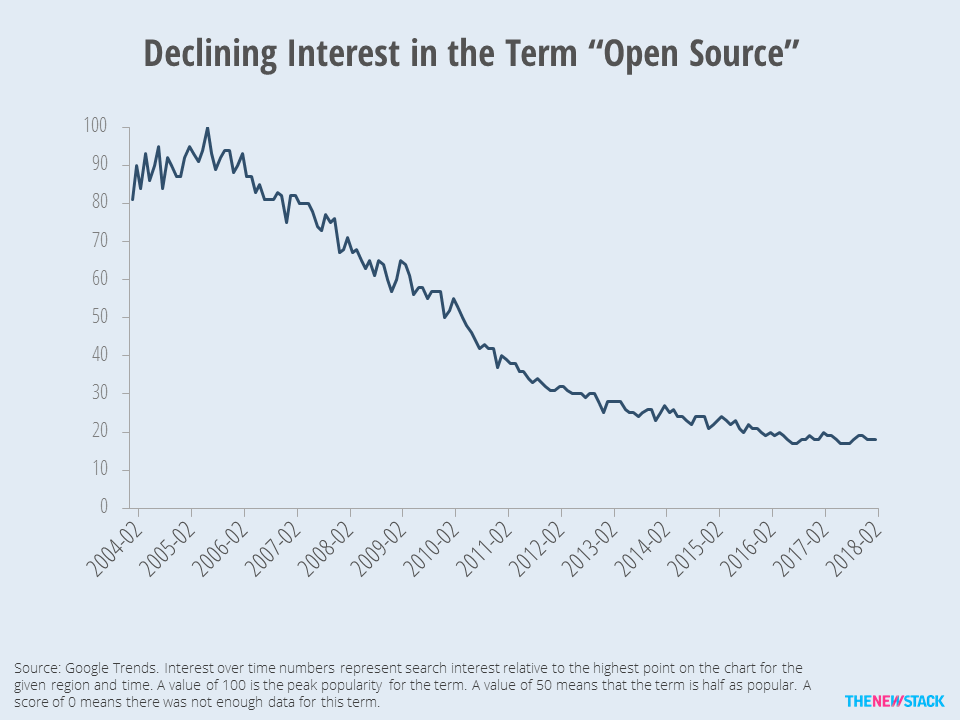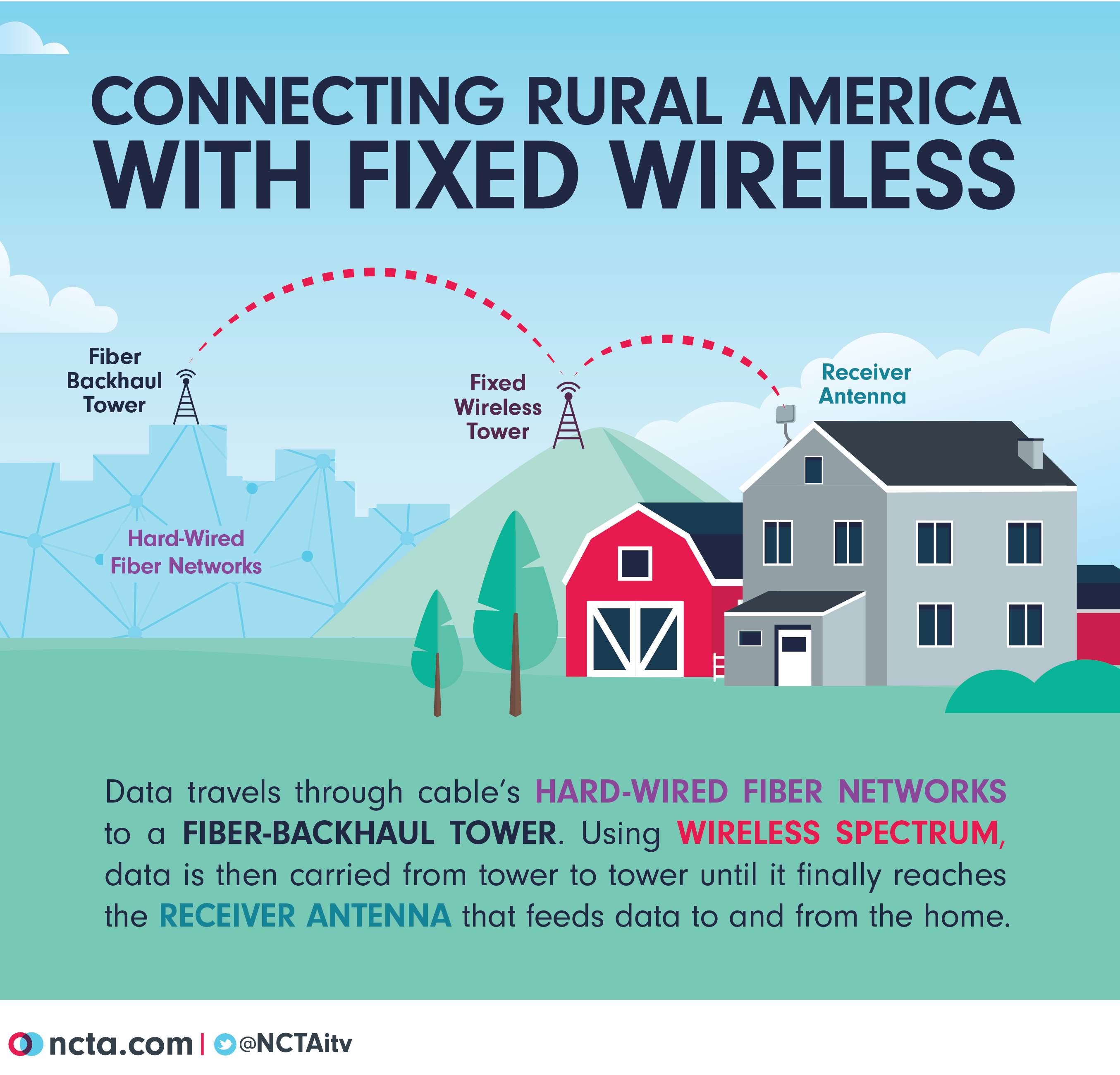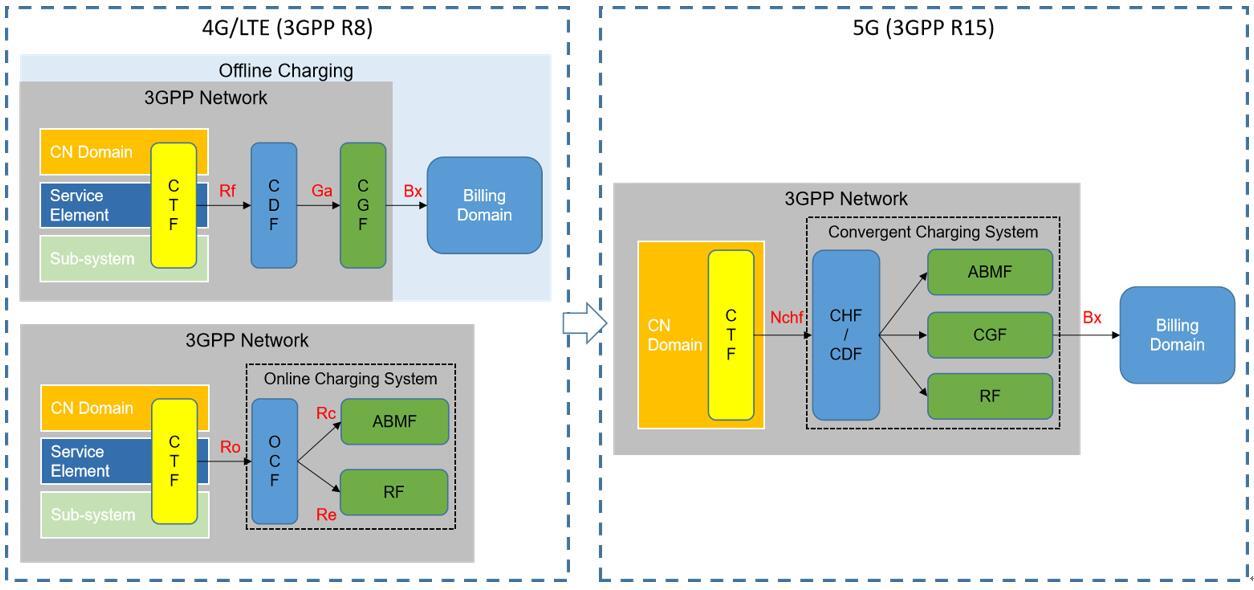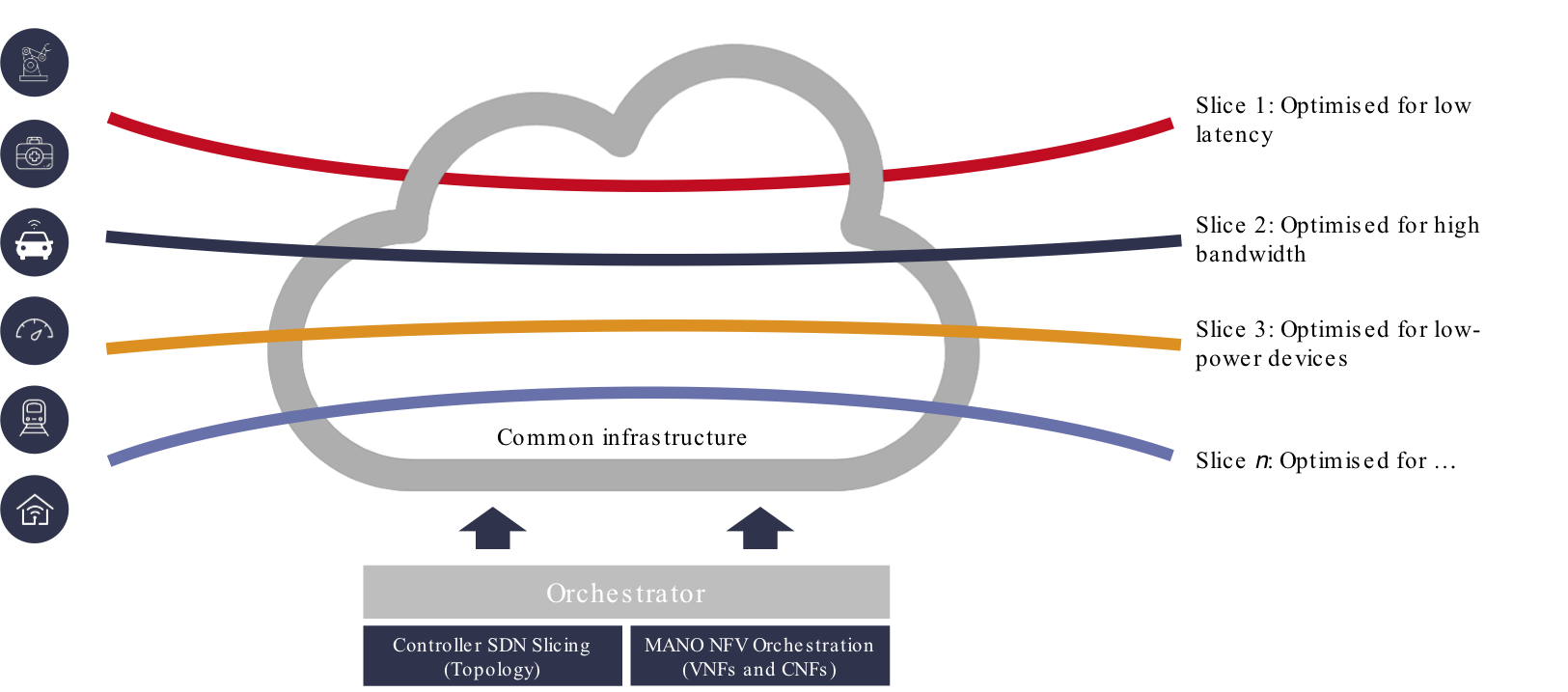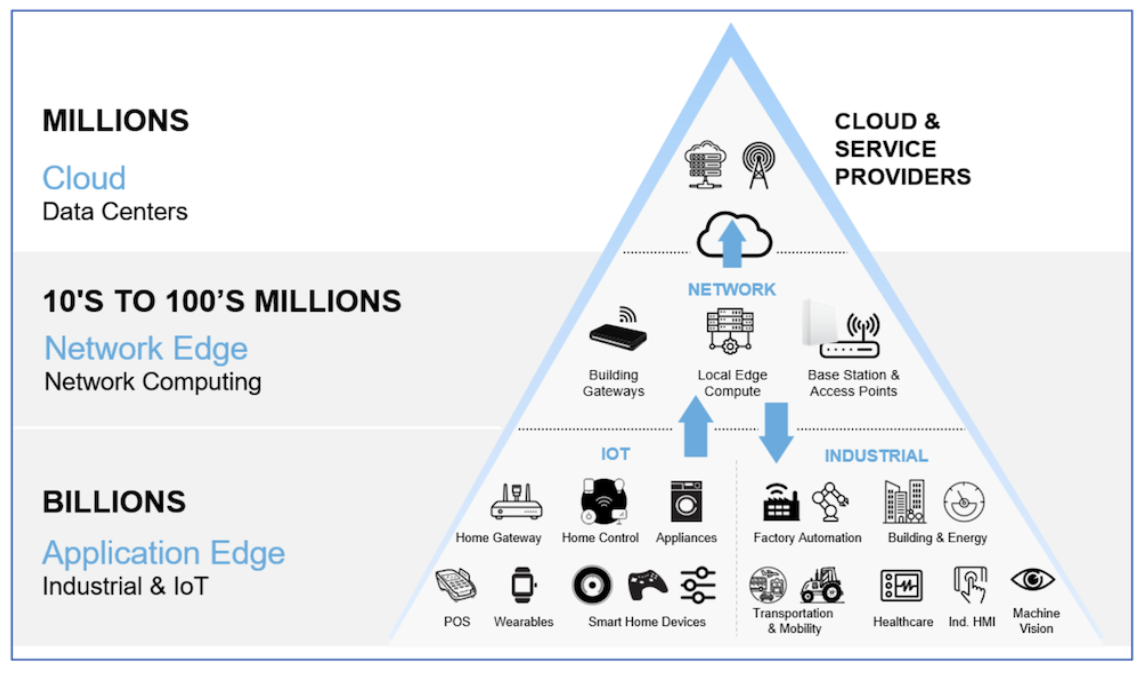This year saw a more-rapid-than-ever growth in the telco 5G ecosystem. With bigger investments in research and development, improved network coverage, and government support, the business breakthroughs of 5G are more compelling than ever.
But just as it’s critical for telcos to act quickly to seize the dramatic new business opportunities of 5G, so too is it important to step back and assess the new directions key 5G technologies are likely to take in 2022, and prepare accordingly for how these pivots will affect your data infrastructure and tech stack.
Here are the top five trends and changes we see coming in 2022 for the telco market.
1. The end of open source databases
Overall interest in open source technology has been declining for many years, as clearly evidenced by Google search trends (see chart below). By the end of this year, it’s very likely that there will be no true open-source databases left (with Postgres being the one honorable exception).
Open source database software flourished as a welcome respite from legacy RDBMS products and their hefty acquisition and ongoing maintenance costs. Unfortunately, today’s open source database vendors are deploying prohibitive business tactics that increasingly resemble those of the original proprietary RDBMS oligarchy.
Why?
Because open source vendors have all received substantial VC funding, they now must make their investors happy. Doing so requires actions that are also making developers quite unhappy—to the point of having to rethink their use of their DB platforms—as well as flying in the face of basic tenets of the open source software model.
In addition to increased “feature bloat” intended to encourage customers to migrate from legacy RDBMS, open source vendors have established restrictive Server Side Public Licencing (SSPL) designed to prevent cloud service providers from offering their software as a service, so vendors themselves can offer their database as a service (DBaaS). Apart from the inevitable source code forks and product delays related to developer uncertainty, there’s also legal ambiguity as to whether “third parties” noted in SSPLs might also apply to large corporations consisting of dozens or even hundreds of different business entities.
The Open Source Initiative recently condemned SSPLs as “deception, plain and simple,” while also stating the vendors in question now have “a current business model inconsistent with what open source licenses are designed to do. Its current business desires are what proprietary licenses (which includes source available) are designed for” [emphasis added].
2. Fixed Wireless Access
With 5G’s dramatically upgraded speeds and coverage, the time has come for wide deployment of fixed wireless access (FWA), to connect new masses of people with true broadband Internet. Look for 2022 to bring an increasing use of FWA in what will be an FWA renaissance, of sorts.
FWA uses radio waves to provide high-speed, high-capacity internet service without the need for an underground cable or fiber optic connection. FWA is hardly new—it’s been around since the 1980’s—but it remains a popular alternative to fiber, has been supported by 5G from the start, and remains the only viable solution for providing broadband connectivity to rural US communities. It is also becoming an important complement to traditional wireless networks in dense urban areas.
5G promises compelling performance improvements over the latest 4G LTE network deployments. As FWA operators get access to more of the 5G frequencies, coupled with new national efforts to revitalize US infrastructure, including billions to fund new broadband service, FWA will provide significantly greater bandwidth and higher data rates to new customers, which will undoubtedly lead to increased demand for this service.
3. Real-time convergent charging
Convergent charging powered by real-time decisioning will be a must-have for telco providers in our new age of 5G, for prepaid and postpaid charging alike.
A converged charging system provides the ability to control services and manage balances in real time. This includes, for example, authenticating the subscriber and checking the account balance before service delivery to the end user, notifying users when the account balance threshold set by the operator the subscriber themselves (self-set usage/spend limits need to be managed in real time) is reached, and terminating service connectivity when real-time charging indicates that credit has been depleted.
Convergent charging architecture for 5G
Source: 3GPP
Prepaid charging clearly requires a converged charging system; however, those who believe that postpaid charging scenarios do not have a real-time requirement should think again. First off, customers simply expect mobile app usage buckets and spend accumulators to be accurate in real time. Additionally, real-time charging enables providers to offer bundled family-friendly, multiuser service packages that innovatively combine pre- and postpaid services, complete with unified billing. Finally, government regulations requiring providers to monitor and communicate postpaid spend to users in real time to avoid “bill shock”, as well as evolving 5G standards, will increasingly require real-time postpaid charging.
4. Dynamic 5G network slicing
A recent Amdocs survey found 84% of service providers plan to trial 5G network slicing in the near future. Doing so successfully will yield a clear competitive advantage in how providers manage traffic and user access with an exciting new level of operating efficiency.
The ultimate goal of dynamic network slicing, which enables operators to design, deploy, customize, and optimize the various network slices running on a common network infrastructure, is to optimize 5G networks so that they efficiently address all use cases.
How dynamic network slicing works
Source: STL Partners
As an example, operators and service providers can use real-time metrics to dynamically “slice” LTE network traffic (such as for that between IoT device) according to how it’s performing against SLA KPIs. Such traffic could then be monitored in real time and certain LTE traffic can be dynamically shifted to 5G slices if and when the LTE network starts to trend unfavorably with KPIs.
5. AI and ML at the edge
Gartner estimates that 75% of data will be generated and processed at the edge by 2025.
Reducing latency to the lowest possible level requires maximizing edge computing and processing of edge data. But successfully processing data at the edge, without then overloading your data centers with the raw data resulting from that processing, will require the application of advanced analytic models notably, artificial intelligence (AI) and machine learning (ML).
Communication service providers, (CSPs) and network operators will increasingly need to rely on AI and ML to manage, organize, and increase the efficiency of the 5G network itself and to get the most out of the torrents of data being generated by 5G use cases, thereby making real time, 5G-ready data platform technology more vitally important for success than ever.
Switching from cloud to edge computing may lead to the building of billions of devices that run ML-enabled software
Source: NXP
Unlike previous generations of wireless technology, 5G was designed specifically for the cloud and for massive, superfast connectivity. For example, 5G can connect billions of IoT sensors to edge data centers for AI processing. 5G thus presents a golden opportunity to ramp up innovation for telcos that can successfully deploy AI and ML applications on 5G networks.
But today’s 5G and AI infrastructures are generally inefficient because they’re deployed and managed separately. For telcos, using AI and ML in conjunction with 5G networks will open up exciting new use cases and revenue streams, enabling them to convert every 5G station into an edge data center capable of supporting 5G workloads as well as new AI and ML services.

